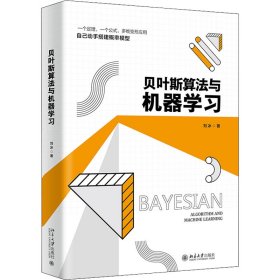
机器学习:贝叶斯和优化方法(英文版)
¥ 65 2.4折 ¥ 269 九品
仅1件
作者[希]西格尔斯·西奥多里蒂斯 著
出版社机械工业出版社
出版时间2017-05
版次1
装帧平装
货号16-4
上书时间2024-07-04
- 店主推荐
- 最新上架
商品详情
- 品相描述:九品
图书标准信息
- 作者 [希]西格尔斯·西奥多里蒂斯 著
- 出版社 机械工业出版社
- 出版时间 2017-05
- 版次 1
- ISBN 9787111565260
- 定价 269.00元
- 装帧 平装
- 开本 16开
- 纸张 胶版纸
- 页数 1050页
- 丛书 经典原版书库
- 【内容简介】
-
本书对所有主要的机器学习方法和新研究趋势进行了深入探索,涵盖概率和确定性方法以及贝叶斯推断方法。其中,经典方法包括平均/小二乘滤波、卡尔曼滤波、随机逼近和在线学习、贝叶斯分类、决策树、逻辑回归和提升方法等,新趋势包括稀疏、凸分析与优化、在线分布式算法、RKH空间学习、贝叶斯推断、图模型与隐马尔可夫模型、粒子滤波、深度学习、字典学习和潜变量建模等。全书构建了一套明晰的机器学习知识体系,各章内容相对独立,物理推理、数学建模和算法实现精准且细致,并辅以应用实例和习题。本书适合该领域的科研人员和工程师阅读,也适合学习模式识别、统计/自适应信号处理和深度学习等课程的学生参考。
- 【作者简介】
-
SergiosTheodoridis希腊雅典大学信息系教授。主要研究方向是自适应信号处理、通信与模式识别。他是欧洲并行结构及语言协会(PARLE-95)的主席和欧洲信号处理协会(EUSIPCO-98)的常务主席、《信号处理》杂志编委。
KonstantinosKoutroumbas1995年在希腊雅典大学获得博士学位。自2001年起任职于希腊雅典国家天文台空间应用研究院,是国际知名的专家。
- 【目录】
-
Contents
Preface.iv
Acknowledgments.vv
Notation.vfivi
CHAPTER 1 Introduction .1
1.1 What Machine Learning is About1
1.1.1 Classification.2
1.1.2 Regression3
1.2 Structure and a Road Map of the Book5
References8
CHAPTER 2 Probability and Stochastic Processes 9
2.1 Introduction.10
2.2 Probability and Random Variables.10
2.2.1Probability11
2.2.2Discrete Random Variables12
2.2.3Continuous Random Variables14
2.2.4Meanand Variance15
2.2.5Transformation of Random Variables.17
2.3 Examples of Distributions18
2.3.1Discrete Variables18
2.3.2Continuous Variables20
2.4 Stochastic Processes29
2.4.1First and Second Order Statistics.30
2.4.2Stationarity and Ergodicity30
2.4.3PowerSpectral Density33
2.4.4Autoregressive Models38
2.5 InformationTheory.41
2.5.1Discrete Random Variables42
2.5.2Continuous Random Variables45
2.6 Stochastic Convergence48
Problems49
References51
CHAPTER 3 Learning in Parametric Modeling: Basic Concepts and Directions 53
3.1 Introduction.53
3.2 Parameter Estimation: The Deterministic Point of View.54
3.3 Linear Regression.57
3.4 Classification60
3.5 Biased Versus Unbiased Estimation.64
3.5.1 Biased or Unbiased Estimation?65
3.6 The Cramér-Rao Lower Bound67
3.7 Suf?cient Statistic.70
3.8 Regularization.72
3.9 The Bias-Variance Dilemma.77
3.9.1 Mean-Square Error Estimation77
3.9.2 Bias-Variance Tradeoff78
3.10 MaximumLikelihoodMethod.82
3.10.1 Linear Regression: The Nonwhite Gaussian Noise Case84
3.11 Bayesian Inference84
3.11.1 The Maximum a Posteriori Probability Estimation Method.88
3.12 Curse of Dimensionality89
3.13 Validation.91
3.14 Expected and Empirical Loss Functions.93
3.15 Nonparametric Modeling and Estimation.95
Problems.97
References102
CHAPTER4 Mean-quare Error Linear Estimation105
4.1Introduction.105
4.2Mean-Square Error Linear Estimation: The Normal Equations106
4.2.1The Cost Function Surface107
4.3A Geometric Viewpoint: Orthogonality Condition109
4.4Extensionto Complex-Valued Variables111
4.4.1Widely Linear Complex-Valued Estimation113
4.4.2Optimizing with Respect to Complex-Valued Variables: Wirtinger Calculus116
4.5Linear Filtering.118
4.6MSE Linear Filtering: A Frequency Domain Point of View120
4.7Some Typical Applications.124
4.7.1Interference Cancellation124
4.7.2System Identification125
4.7.3Deconvolution: Channel Equalization126
4.8Algorithmic Aspects: The Levinson and the Lattice-Ladder Algorithms132
4.8.1The Lattice-Ladder Scheme.137
4.9Mean-Square Error Estimation of Linear Models.140
4.9.1The Gauss-Markov Theorem143
4.9.2Constrained Linear Estimation:The Beamforming Case145
4.10Time-Varying Statistics: Kalman Filtering148
Problems.154
References158
CHAPTER 5 Stochastic Gradient Descent: The LMS Algorithm and its Family .161
5.1 Introduction.162
5.2 The Steepest Descent Method163
5.3 Application to the Mean-Square Error Cost Function167
5.3.1 The Complex-Valued Case175
5.4 Stochastic Approximation177
5.5 The Least-Mean-Squares Adaptive Algorithm179
5.5.1 Convergence and Steady-State Performanceof the LMS in Stationary Environments.181
5.5.2 Cumulative Loss Bounds186
5.6 The Affine Projection Algorithm.188
5.6.1 The Normalized LMS.193
5.7 The Complex-Valued Case.194
5.8 Relatives of the LMS.196
5.9 Simulation Examples.199
5.10 Adaptive Decision Feedback Equalization202
5.11 The Linearly Constrained LMS204
5.12 Tracking Performance of the LMS in Nonstationary Environments.206
5.13 Distributed Learning:The Distributed LMS208
5.13.1Cooperation Strategies.209
5.13.2The Diffusion LMS211
5.13.3 Convergence and Steady-State Performance: Some Highlights218
5.13.4 Consensus-Based Distributed Schemes.220
5.14 A Case Study:Target Localization222
5.15 Some Concluding Remarks: Consensus Matrix.223
Problems.224
References227
CHAPTER 6 The Least-Squares Family 233
6.1 Introduction.234
6.2 Least-Squares Linear Regression: A Geometric Perspective.234
6.3 Statistical Properties of the LS Estimator236
6.4
相关推荐
— 没有更多了 —
































以下为对购买帮助不大的评价